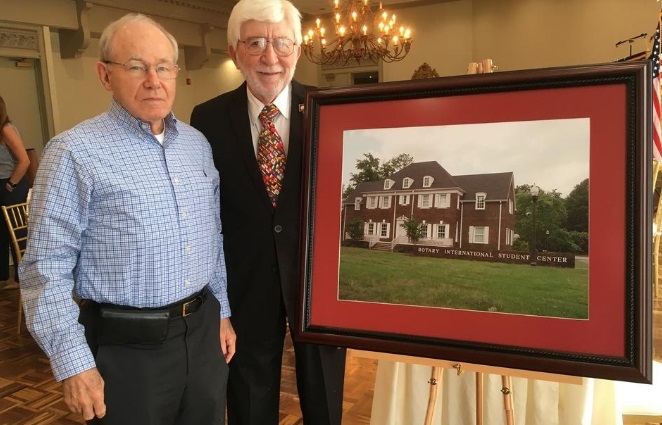With more than $900,000 now having been raised and contributed to community projects by the Rotary Club of Tuscaloosa (Alabama, US – D 6860) during the past 45 years, the club paused last week to recognise its first project.

That was a $60,000 investment in the Rotary International Student Centre (RISC), on the University of Alabama campus.
The RISC continues to offer living space and meeting rooms for students from countries around the world, as an outreach of Rotary’s dedication to international service.
A large framed picture of the first facility was displayed at the club’s Sept 4 meeting and will be hung on the wall of what is more recently called the Rotary International House (RIH).
Rotarian Omar Smith, who chairs the club’s international committee, said the international centre has endured these 45 years “as testimony to the club’s support and influence of worthy projects.”

But that original building could not survive. Its condition, plus space needs, led UA to offer Rotary a larger facility, which now provides a residence for 14 students from six countries.
For those living in the Rotary International Student Centre during the past 45 years, it has been more than a residence. It was once spoken of as a “Little United Nations.”
As many as 60 former residents stayed in touch through an Internet blog, posting messages from their various countries.
Manolo Mayorga wrote from Spain, “I still remember very vividly how my life has been reshaped because of my decision to live at the Rotary House.”
Another resident said the common bond uniting RISC alumni “was the spirit of friendship that would never have become a reality” if not for what residents dubbed “the red brick house on University Boulevard.”
Arriving with the baggage of their respective homelands, international students soon learned to look beyond political and governmental confrontations.
They found themselves replacing preconceived notions of distrust with individual and personal respect.
A Muslim from Pakistan and a Hindu from India put aside political and religious differences as their shared interest in engineering drew them into a personal friendship.
A Turk and a Greek bonded in mutual respect through their public relations classes, seeing each other individually and no longer through the stereotypes of their national rivalries.
In this residential environment, international understanding emerged as misunderstanding faded into the background.
In this new school year, Smith anticipates the RIH “as a catalyst for interacting with other international groups.”
He recently visited with members of the Japanese-American Culture Club, and sees cooperative ventures further developing international understanding and friendships.
“I’d like to see the house as a place to build up connections, groups with similar purposes but who could accomplish more in cooperative effort.”
Rotarians were reminded, at their recent meeting, of the RISC dedication on a very hot day, Sept 3, 1973.
Club members gathered on the porch and lawn, as Rotary International president, William C Carter, from London, England, came to participate in the dedication.
The world president of Rotary called it an example of the international organisation’s goal of “doing good in the world.”
Charlie Snyder, a past club president and past district governor, was a leader in the money-raising for the house, and he was co-chairman of the building committee.
Later, and in his memory, Rotarians gave and dedicated a display cabinet, which now houses historical memorabilia plus a collection of international dolls contributed by Rotarian Glenda Guyton.
Only seven currently active club members remain of those who were members when the RISC was dedicated.
They are John Duckworth, Gary Fitts, Bill Jessup, Joe B Duckworth, John Owens, Frank Deaver and Bruce Baughman, plus honorary members Bob Amason and Jim Shamblin.
In 1971, the Rotary Club created the Tuscaloosa Rotary Memorial Foundation (TRMF), a separate legal entity, to provide a 501-C3 vehicle for tax-deductible contributions to club projects.
On an approximate three-year cycle, club members propose a project and pledge their contributions.
TRMF President Rufus Lewis said pledges can be paid over the three-year cycle, adding that most members participate, pledging varying amounts.
One member said that although he cannot contribute as much as some others, he always pledges what he can, because “I want to feel that I’m a part of it.”
Most often, Lewis said, the TRMF has funded capital projects, brick-and-mortar entities that will have a lasting presence in the community.
On the other hand, he pointed out, a lesser number of projects have been financial support of a worthy effort, such as “Strings in Schools” and the current $100,000 support of the “MLK Reading-by-the-Third-Grade” literacy initiative.
With two dozen projects over these 45 years, Lewis said, it’s safe to say that “in one way or another, virtually every citizen of Tuscaloosa County has been touched by the service projects of Rotary.”
Source: The Tuscaloosa News





